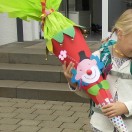The most important part of every German child's first day of school is the "Schultüte," or school cone. Apparently the thought of attending school every day for the next 12-13 years has to be "sweetened" with candy and presents - a tradition that dates back to the early 19th century.
Parents fill the cones, either homemade or purchased, with treats, school supplies and small gifts.
This transition is associated with many changes for the child and for the family and that's what people want to emphasize with the ritual.
The first written references date back to the late 18th century.
At that time, there were no pre-made cones. Instead, people used the paper cones that were used in shops to wrap up sweets.
The early references come from what is now central Germany in the regions of Thuringia, Saxony, Saxony-Anhalt and perhaps also Rhineland-Palatinate.
Those are the main areas where the tradition has spread - they form a kind of belt across the middle of Germany.
Those are also the regions in which very elaborate traditions have developed around the school cone.
The cone itself is not a tradition, it's an element used in a tradition and it's also simply packaging.
It's sometimes also presented to young adults starting vocational school as well.
That shows that it's seen as a symbol for a new beginning.
Back then, usually the same things that are put in the cones today.
Then it was called "Zuckerzeug" - literally "sugar stuff," or basically candy.
Today, you'll find sweets, things to play with and school supplies. The school cone is really just a container, which means you can't look inside of it. And it's not opened at school but afterwards at home.
That means that if I'm financially not in a position to fill up the cone with presents, I can fill it out with extras.
So people threw in potatoes or paper. In one instance, a wooden shoe was put in the bottom of the cone. But we can see that this symbol for school beginners was so important that no one wanted to do without it.
As with many things, it's been exaggerated. People spend an incredible amount of money on it. For the cone alone, they spend between 3 and 40 euros ($3.40-45.30).
As per a small and non-representative survey in Münster, which isn't one of the main regions for this tradition. Three-quarters of those polled said they made the cone themselves, while one-quarter said they bought it. In the area where the cones are most common, people don't just give new first-graders one, but several cones.
Then they also order a cake from the local bakery with the child's name on it. In Saxony-Anhalt, for example, that's very common. Since the 19th century, people have spent days baking and planning and organizing to celebrate with relatives and neighbors. And they also buy presents for their neighbors' children.

 0
0
